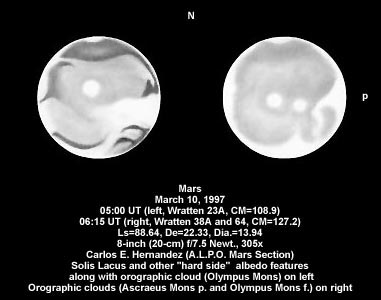

The red (Wratten 23A) light drawing of Mars on the left was made on March 10, 1997 (Ls=88.64, De=22.33) at 05:00 UT (CM=108.9) by Carlos E. Hernandez (A.L.P.O. Mars Coordinator) using an 8-inch (20-cm) f/7.5 Newtonian reflector at 305x. The North Polar cap (NPC) appears small and brilliant (10/10) on the northern limb apparently surrounded by a dark to dusky (3-4/10) collar consisting of Baltia, Mare Boreum, Abalos, Nerigos, Ierne, Scandia, and Lemuria. The f., or western border of Mare Acidalium is visible on the p., or evening, limb. Idaeus Fons appears as a dark (3/10) triangular-shaped albedo feature prominent north of a very bright to extremely bright (8-9/10) cloud over Chryse-Xanthe which obscures albedo features such as Ganges, Lunae Lacus and Nilokeras. This cloud extends over the Candor-Tharsis region and appears to connect, after passing through Syria, to an extremely bright SLH over the Daedalia-Claritas region. Solis Lacus and Tithonius Lacus are visible as dark (3/10), expanded projections extending from Mare Erythraeum. Mare Sirenum appears dusky (4/10) and surrounded by a very bright to extremely bright (8-9/10) border over Memnonia and the southern limb. A very bright (8/10) orographic cloud (most probably associated with Olympus Mons considering it's position) is visible over the Tharsis-Amazonis region. The Trivium Charontis-Cerberus (I) complex is visible on the f., or morning, limb with a dark to dusky (3-4/10) Phlegra-Styx region Np. it apparently enclosing an extremely bright (9/10) Elysium on the f. limb. The Propontis complex (Propontis I and II as well as Castorius Lacus; at times including Euxinus Lacus) appears as a dark (3/10), wedge-shaped albedo feature adjacent to the Nf. limb. A thin, dusky (4/10) projection appears to extend from the Trivium Charontis-Cerberus (I) complex over the Amazonis-Mesogaea region possibly representing Eumenides-Orcus (it may also represent a contrast effect between two dissimilar bright regions).
The blue (Wratten (38A) and blue-green (Wratten 64) drawing on the right was made on the same date as above at 06:15 UT (CM=127.2) using the same equipment as previously described. The North Polar Cap (NPC) appears small and brilliant (10/10) on the northern limb. An extremely bright (9/10) cloud appears to project from an equally bright ELH over the Chryse-Xanthe region then extend, slightly undulating, over Candor, Syria and finally connecting to an extremely bright (9/10) SLH over the Daedalia-Claritas region. Two very bright (8/10) orographic clouds are noted over the center of the disk over the Tharsis-Amazonis region. The smaller p. cloud most probably represents an orographic cloud associated with the martian volcano Ascraeus Mons (104 degrees West, 12 degrees North) whereas the larger cloud f. the CM most probably represents a orographic cloud associated with the mighty martian volcano Olympus Mons (113 degrees West, 18 degrees North).
(Legend: N.=north, S.=south, p.=preceding, f.=following, Np.=north-preceding, Nf.=north-following, Sp.=south-preceding, Sf.=south-following, MLH=morning limb haze, ELH=evening limb haze, and SLH=southern limb haze)